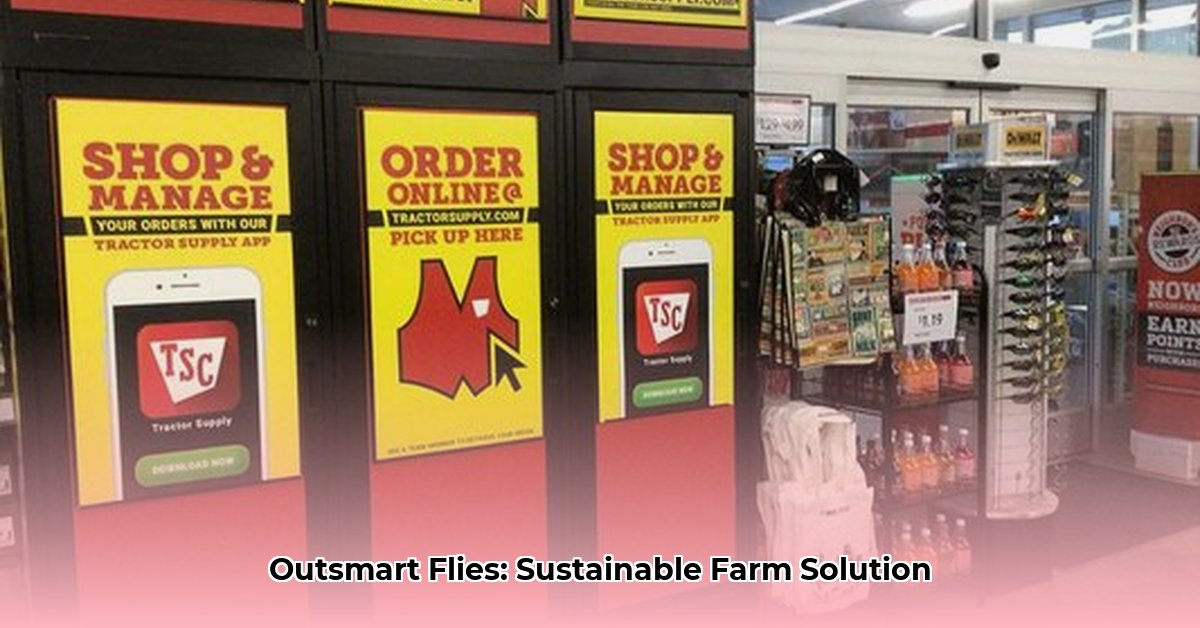
Fly Bags from Tractor Supply: A Sustainable Approach to Fly Control
Dealing with flies on your farm presents a significant challenge. They're more than just a nuisance; they spread disease, impact livestock health, and ultimately hurt your bottom line. Traditional methods often rely on harsh chemicals, harming the environment and potentially impacting the safety of your produce. This guide explores a more sustainable approach: using fly bags from Tractor Supply as a component of a comprehensive integrated pest management (IPM) strategy. We'll provide a step-by-step guide to their use, compare them to other sustainable methods, and explain how to integrate them into a broader, environmentally conscious pest control plan. For more information on Tractor Supply's fly control options, check out this helpful resource.
Understanding Tractor Supply Fly Bags
Tractor Supply offers fly bags designed for outdoor use, providing a relatively simple and disposable solution to fly infestation. These aren't your average fly swatters; these are large, heavy-duty bags intended to attract and trap significant numbers of flies. They operate by using attractants to lure the flies into a contained space, effectively removing them from the environment. The bags are typically constructed from durable, weather-resistant materials and are designed for single use, simplifying disposal and minimizing messy clean-up. The attractants used generally mimic natural scents to entice flies.
How to Use Tractor Supply Fly Bags Effectively: A Step-by-Step Guide
Maximizing the effectiveness of fly bags hinges on proper placement and regular maintenance. Follow these steps for optimal results:
Strategic Placement: Hang the bags in areas where flies congregate—near manure piles, garbage bins, or livestock areas. Avoid direct sunlight, choosing shaded areas with good air circulation to preserve the attractant’s potency. Placement is key!
Attractant Application (if necessary): Some bags come pre-baited, while others require you to add attractant. Always follow the manufacturer's instructions meticulously. A strong attractant is crucial for drawing large numbers of flies. Isn't a strong attractant vital for success?
Regular Monitoring & Maintenance: Check the bags frequently, ideally every few days, or more often during peak fly season. Overfilled bags become significantly less effective. If the attractant dries out, consider adding more to maintain its effectiveness.
Proper Disposal: Once a bag is full, seal it tightly to prevent fly escape and dispose of it according to local regulations. Responsible disposal is paramount for environmental protection.
Replacement Schedule: Determine a replacement frequency based on factors such as farm size, fly population density, weather conditions, and attractant type. During warmer months and periods of high fly activity, more frequent replacements will be necessary.
Weighing the Pros and Cons of Tractor Supply Fly Bags
Like any pest control method, fly bags possess both advantages and disadvantages. A balanced assessment is essential for informed decision-making.
Pros:
- Ease of Use: Simple to set up and use, requiring minimal training or specialized equipment.
- Relatively Low Initial Cost: The upfront cost is generally affordable.
- Minimal Maintenance: Requires only regular monitoring and replacement.
- Improved Hygiene: Reduces direct contact with flies, minimizing disease transmission risks. Is this reduced risk a significant selling point for your farm?
- More Environmentally Friendly Than Chemical Pesticides: They represent a less toxic alternative to harsh chemical control.
Cons:
- Variable Effectiveness: Effectiveness is influenced by multiple factors, including weather, fly density, and the type of flies present. They aren't a guaranteed solution.
- Recurring Costs: Continuous replacement leads to ongoing expenses.
- Not a Permanent Solution: They address symptoms rather than the underlying cause of the infestation.
- Aesthetics: The visual impact of numerous hanging bags might not be desirable for all farms.
- Attractant Limitations: The efficacy of attractants varies among different fly species.
Beyond Fly Bags: A Holistic Approach to Fly Control
While fly bags can be a valuable tool, they're most effective as part of a larger IPM strategy. A multi-pronged approach is crucial for sustainable fly management.
Sanitation: Proper manure management is paramount, eliminating breeding grounds through regular removal and composting. Efficient composting reduces breeding sites. What are your current manure management practices?
Natural Predators: Encourage beneficial insects and birds that feed on flies. A healthy ecosystem can significantly reduce fly populations.
Biological Control: Consider using beneficial nematodes, which target fly larvae. This is a natural and sustainable method.
Targeted Pesticide Use (Only as a Last Resort): If sustainable methods prove insufficient, use eco-friendly pesticides sparingly and exclusively as instructed on the label.
Building Your Integrated Pest Management (IPM) Strategy
An IPM strategy employs multiple, complementary methods, minimizing reliance on chemical pesticides. This layered approach enhances efficacy and environmental responsibility.
- Sanitation: The cornerstone of fly control. Regularly remove and compost manure.
- Fly Bags: A valuable tool for targeting adult flies. Strategically place them to trap flies.
- Biological Control: Integrate natural predators where feasible.
- Monitoring: Continuously monitor fly populations and adjust your strategy based on observed results. How often do you currently monitor fly populations on your farm?
This integrated approach creates a more sustainable and effective solution than relying solely on one method.
How to Choose Environmentally Friendly Fly Traps for Sustainable Farming
Choosing the right fly control method depends on your farm's unique circumstances, your budget, and your environmental priorities. Thorough consideration of the pros and cons detailed above enables informed decision-making and assists in selecting the most appropriate method for your specific needs. A balanced and sustainable approach remains the most responsible and effective method for long-term fly control.